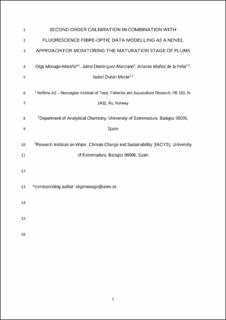| dc.description.abstract | In this work, non-destructive autofluorescence of plums was employed to study the chlorophylls’ concentration evolution along the maturation process. For that, excitation-emission matrices (EEMs), containing full fluorescence information, were collected with a fibre-optic, assembled to a spectrofluorometer. Data analysis was performed with several second-order multi-way algorithms, such as parallel factor analysis (PARAFAC), multi-way partial least-squares (N-PLS), unfolded partial least-squares (U-PLS), and multivariate curve resolution-alternating least-squares (MCR-ALS). Firstly, the EEMs of each plum, collected each week along the maturation process, were processed with PARAFAC. Two components were used to model the data and the excitation and emission loadings were obtained. Score values for the first PARAFAC component showed a clear evolution with time, increasing during the first five weeks, and decreasing for the last weeks. Also, the chlorophyll concentrations obtained by HPLC analysis, in the skin and the whole fruit, were compared with those obtained with different algorithms mentioned before. Best results were obtained in the case of skin for all algorithms. Similar correlation coefficients (r) were obtained in all cases (0.899 (PARAFAC); 0.940 (U-PLS); 0.936 (N-PLS) and 0.958 (MCR-ALS)). When the elliptical joint confidence region (EJCR), for the slope and intercept, were calculated, the theoretically expected values of 1 and 0, for the slope and intercept, respectively, were included in all ellipses. However, it was observed that for the skin data and U-PLS and N-PLS algorithms, the EJCR confidence region was smaller than in the other cases. | |
